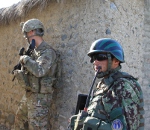Apache crash in Paktika
Video of a US Army AH-64 Apache attack helicopter crashing in Paktika province, Afghanistan on Feb. 6. According to The Huffington Post:
Justin M. Brockhoff, spokesman for the ISAF, reiterated the Stars and Stripes post, saying that two AH-64s were "gathering supplies that were airdropped earlier in the day" and that "one of the aircraft crashed, and thankfully no one on the ground was injured and both members of the aircrew survived."Brockhoff said an investigation is underway by U.S. Army officials to "determine the cause and any other factors behind the incident."
ABC News reports that the helicopter appeared to be performing a "return to target" maneuver, described as a "low swoop followed up by the 180 degree turn followed by another swoop," an aerial move that helicopter pilots would be extensively trained to do.
According to Wired, during correspondent David Axe's visit to Afghanistan in January, helicopters regularly buzzed low "as a demonstration of American power" and "a morale boost for the isolated troops."
My article last August in Wired highlighted some of the difficulties inherent to flying helicopters in Afghanistan's thin air:
As pilots transit the mountainous, thin air of Afghanistan, they constantly monitor two metrics: "density altitude" is the aircraft's effective altitude when factoring in the temperature. For example, while the aircraft may be physically at 5,000 feet above sea level, the density altitude may be 7,000 feet when factoring in a hot temperature.The other metric is "tab data," a measure that calculates what the helicopter's maximum power is at any given combination of altitude and temperature. When this max power is cross-referenced against the weight of the aircraft at the time, pilots can determine whether they have enough lift to sustain a given flight maneuver or mission in a given area. That helps them avoid an unplanned landing or crash. But even with due diligence, Afghanistan presents unique challenges.
"Afghanistan is weird," explains Black Hawk pilot Chief Warrant Officer 2 Steve Atencio. "Temperature change doesn't occur the same as it does back home, for some reason. There is usually a standard lapse rate [in temperature]. You gain or lose 2 degrees [as you descend or ascend a certain altitude], but for some reason here, it's more dramatic. We're continually looking at that tab data to ensure you won't have a mishap."
The danger of thin air was starkly illustrated a couple of weeks ago, when a Tigershark Apache helicopter crash-landed at about 11,000 feet. Though the incident is still under investigation, early reports suggest the pilot banked too hard for the thin air, and lost sufficient lift under the rotors. He successfully crash landed on a mild slope -- no easy feat among the jagged ridges in the area of the crash -- but the aircraft was eventually destroyed after several failed attempts to airlift it out of the mountains with twin rotor Chinooks.
And if the ad hoc calculations regarding heat and thin air weren't complicated enough, helicopter pilots must also pay attention to Afghanistan's fickle mountain winds. When an aircraft flies into a head wind, it loses speed but gains performance; the rushing wind acts as an air foil that grants the helicopter maneuverability. If the pilot makes a sudden turn perpendicular to or opposite the wind, the aircraft quickly loses this extra performance, and a pilot's failure to compensate -- for example, starting to pull up from a dive too late -- could precipitate a crash into a mountainside.

READER COMMENTS: "Apache crash in Paktika"
Posted by Muhammad Imran/mi1400 at March 25, 2012 1:13 PM ET:
ppl on other sites are calling pilot an idiot ... How come pilot is idiot !?! the manuver he made to save ground cabins and reduce his speed (making virtical slide to acquire max belly drag and utilize remaining rotor thrust), the hundreds of Gs he suffered on crash!?! I m just wondering if he would have crashed it on some nearby hill slope to turn his crash into slide or roll. pilot's cage and strapings could have saved him. Also since every tom dick and harry is thinking to land on moon ... can someone build the rotor shaft popable .. so pilot would just rlease the rotor crank on some uninhabitant area and some shuttle type shoot decends heli safely to ground !?!